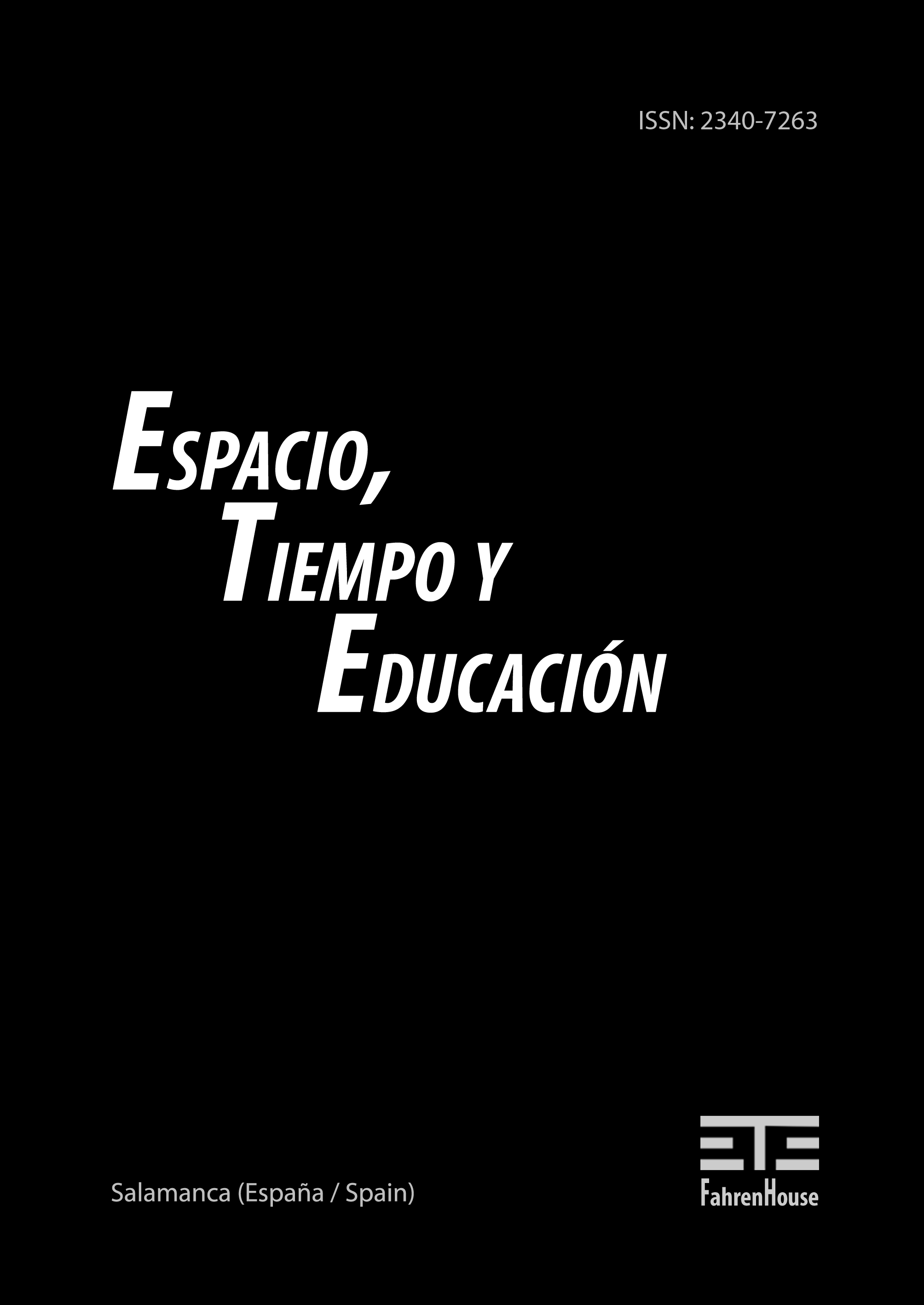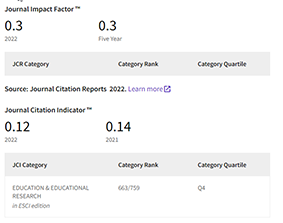Study Abroad and the Transnational Experience of Japanese Women from 1860s–1920s: Four Stages of Female Study Abroad, Sumi Miyakawa and Tano Jōdai
DOI:
https://doi.org/10.14516/ete.322Palabras clave:
study abroad, transnational experience, girls’ and women’s education in Japan, female educatorResumen
This article aims to analyse the study abroad and transnational experiences of Japanese women between the 1860s and the 1920s. First, this article analyses the tendencies, periods, agents (both government-funded and privately-funded), aims and subjects studied in female study abroad in the four stages during this period from school history materials of individual institutions which supported female study abroad. In its later stages, female study abroad tended to strengthen the function of raising leaders of girls’ and women’s education, while in its early stages it tended to introduce a variety of Western culture and academic knowledge. Second, the article focuses on the forms of government- and privately-funded study abroad for women by tracing the study-abroad experience of two women educators in the early 20th century. Within government-funded study abroad, academic disciplines studied and students’ experiences were controlled by the government and focused on building a national female educational system. However, privately-funded study abroad possessed wider aims. It allowed female students to study various academic disciplines and introduced new international trends for promoting women’s social participation. Most female students who experienced study abroad became pioneers of female education and/or social activities in Japan as a result of their transnational experiences.
Referencias
Aoyama, N. (1949). The biography of Tetsu Yasui. Tokyo: Iwanami Shoten (in Japanese).
Department of Education. (1937). Fifty-eighth annual report of the Minister of State for Education 1930-1931. Department of Education Tokyo, Japan.
Duke, B. (2009). The history of modern Japanese education: Constructing the national school system, 1872-1890. New Brunswick, NJ: Rutgers University Press.
Fuchs, E., & Vera, E. (Ed.). (2019). The transnational in the history of education. Cham, Switzerland: Palgrave macmillan.
Fukaya, M. (1966). The education of good wife, wise mother. Tokyo: Reimei Shobo (in Japanese).
A Great Encyclopedia of Christian History of Japan. (1998). Tokyo: Kyobunkwan (in Japanese).
Goodman, J. (2017). Research trends in British history of education: Gender, transnationalism, agency. Journal of children’s studies of Nishikyushu university, 8, 110-122.
Hastings, S. A. (2012). Traveling to learn, learning to lead: Japanese women as American college students,1900-1941. In Freedman, A. Miller, L., & Yano, C. R. (Eds.), Modern girls on the go: gender, mobility, and labor in Japan (pp. 193-208). California: Stanford University Press.
Ishii, N. K. (2004). American women missionaries at Kobe College, 1873-1909: New dimensions in gender. New York: Routledge.
Ishizuki, M. (1992). The history of the studying abroad in Japanese modernization. Tokyo: Chuokoron-sha (in Japanese).
Johnston, L. L. (2005). Contributing to the most promising peaceful revolution in our time: The American women’s scholarship for Japanese women, 1893-1941. In Walton, A. (Ed.), Women and philanthropy in education (pp. 298-319). Bloomington: Indiana University Press.
Japan YWCA. (2015a). One hundred years of Japan YWCA 1905-2005: Towards the self-reliance of women. Tokyo: Japan YWCA (in Japanese).
Japan YWCA. (2005b). One hundred years of Japan YWCA 1905-2005: Timeline. Tokyo: Japan YWCA (in Japanese).
Japan Woman’s University. (2001). An encyclopedia of Japan Women’s University: The track of the 100 years from the founding. Tokyo: Domesu Publishers (in Japanese).
Jōdai, T. (1927). The report of attendance at the congress of WILPF in Dublin. The Home Weekly: the News letter, 891. Tokyo: Japan Women’s College (in Japanese).
Jōdai, T. (1984). The collection of writings by Tano Jōdai. Tokyo: Editorial Board of The Collection of Writings by Tano Jōdai (in Japanese).
Kenjo, T. (Eds.). (2018). The challenge of the association Concordia and Ei’ichi Shibusawa. Kyoto: Minerva Publishers (In Japanese).
Kobe College. (1976). Kobe Jogakuin College 100 years chronicle, general remarks. Kobe: Kobe College (in Japanese).
Kobe College. (1981). Kobe Jogakuin College 100 years chronicle, detail. Kobe: Kobe College (in Japanese).
Kohiyama, R. Y. (1992). As our God alone will lead us: The 19th-century American women’s foreign mission enterprise and its encounter with Meiji Japan. Tokyo: University of Tokyo Press (in Japanese).
Koyama, S. (2012). Ryōsai kenbo: The educational ideal of ‘good wife, wise mother’ in modern Japan. Boston: Brill.
Kwassui Girls’ School. (1929). Kwassui 50 years chronicle. Nagasaki: Kwassui Girls’ School (in Japanese).
Marshall, B. K. (1994). Learning to be modern: Japanese political discourse on education. Boulder, Colorado: Westview Press.
Miyakawa, S. (1903-1906). Sumi Miyakawa’s reports of study abroad and related documents, January 1903 – August 1906. Tokyo Kasei Gakuin University Museum (in Japanese).
Nakamoto, K. (2018). The adolescent education for girls of YWCA: The focusing on the activities in Tokyo YWCA in 1920’s and 1930’s. (Unpublished PhD Thesis). Toyo University, Tokyo (in Japanese).
Nakajima, K., & Sugimori, N. (Eds.). (2006). Women’s peace movement in the 20th century: Women’s International League for Peace and Freedom and Japanese women. Tokyo: Domesu Publishers (in Japanese).
Nimura, J. P. (2015). Daughters of the Samurai: A journey from East to West and back. New York: W.W. Norton.
Nitobe, I. (1920). The Letter from Inazo Nitobe to Tano Jōdai in January 9. Tokyo: Naruse Memorial Archive (in Japanese).
Nitobe, I. (1923). The Letter from Inazo Nitobe to Tano Jodai in June 21. Tokyo: Naruse Memorial Archive (in Japanese).
Ōe, S. (1983). Nyōbō, seppō and teppō: Sanbō ideology. Tokyo: Nihon Tosho Center. (Original work published in 1912) (in Japanese).
Ochanomizu University. (1984). Ochanomizu University 100 years chronicle. Tokyo: Risosha (in Japanese).
Ohama, T. (1978). Mrs Sumi Ōe. Tokyo: Tokyo Kasei Gakuin Kouenkai (in Japanese).
Ouinkai (Ed.). (1940). The history of the Ouinkai. Tokyo: Ouinkai (in Japanese).
Passin, H. (1982). Society and education in Japan. Tokyo: Kodansha /New York: Harper & Row.
Popkewitz, T. S. (Ed.). (2013). Rethinking the history of education: Transnational perspectives on its questions, methods, and knowledge. New York: Palgrave Macmillan.
Raftery, D., & Clarke, M. (Ed.). (2017). Transnationalism, gender and the history of education. London: Routledge.
Research and Statistics Division, Minister’s Secretariat, Ministry of Education, Science and Culture, Government of Japan. (1980). Japan’s modern educational system: A history of the first hundred years. Tokyo: Ministry of Education, Science and Culture.
Sandall, M. (2015). The rise of transnational women’s activism: Identity and sisterhood between the wars. London: I.B. Tauris.
Sasaki, K. (2002). The process of expansion of higher education for women in prewar Japan: A dynamic interaction among institutions, students and government. Tokyo: University of Tokyo Press (in Japanese).
Sasaki, K. (2019). The history of the Ouinkai- the alumni association of the
Tokyo Higher Normal School for Women: A milestone in Japan’s education for women. History of Education, 48(2), pp.233–253.
Sekiguchi, T. (1999). Development of domestic education in Sumi Ooe’ s Thought. Formation of humanity and culture: annual report of Department of Education-Culture-Information Science, Nara Women’s University, 3(3), pp.61-71 (in Japanese).
Shibanuma, A. (2004). Sumi Ōe and Battersea Polytechnic. Bulletin of Keiwa College, 13, 239-252 (in Japanese).
Shibahara, T. (2014). Japanese women and the transnational feminist movement before World War II. Philadelphia: Temple University Press.
Shibuya, R., Uchida, M., & Yamamoto, Y. (2015). A record of the Japanese scholarship 1893-1976: The first study abroad program for Japanese women, Tokyo: Bunshin Publishers (in Japanese).
Shimada, N. (2010). The influence on American education on the founding of Japan Women’s University: How studying in the U.S. influenced Naruse Zinzo and his students. Studies in English and American literature, 45, 61-78 (in Japanese).
Shimada, N., Nakajima, K., & Sugimori, N. (2010). Tano Jōdai: The pioneer in women’s higher education and peace movement. Tokyo: Domesu Publishers (in Japanese).
Takahashi, Y. (2002). The social history of Umeko Tsuda. Tokyo: Tamagawa University Press (in Japanese).
Tezuka, A. & National Education Center (Ed.). (1992). The compendium of the passengers in the last days of the Tokugawa Shogunate and Meiji era. Tokyo: Kashiwashobo (in Japanese).
Tocco, M. (2005). Made in Japan: Meiji Women’s Education. In Molony, B., & Uno, K. (Eds.), Gendering modern Japanese history. Cambridge, Mass: Harvard University Asia Center.
Tokyo Higher Normal School for Women. (1937). Life of the Japanese woman of TO-DAY. Tokyo: Kenkyusha.
Tokyo University of Arts. (1987). Tokyo University of Arts 100 years chronicle: Volume 1 Music. Tokyo: Ongakunotomo-sha (in Japanese).
Tokyo Woman’s Christian University. (1968). Tokyo Woman’s Christian University 50 years chronicle. Tokyo: Tokyo Woman’s Christian University (in Japanese)
Tomita, H. (Ed.). (2005). Biographical dictionary of Japanese travelers to the Occident, 1551-1897. Tokyo: Nichigai Associates (new edition) (in Japanese).
Tomita, Y. (2016). Ōe Sumi (1875–1948) and domestic science in Japan. In Cortazzi, H. (Ed.), Britain & Japan: Biographical portraits (IX, pp. 331-44). Kent: Renaissance Books.
Tsuda College. (1960). Tsuda College 60 years chronicle. Tokyo: Tsuda College (in Japanese).
Tsuji, N. (2010). The change of the aims of the studying abroad in Japanese modernization: The actual condition of the government students abroad. Tokyo: Toshindo (in Japanese).
Tsujimoto, M., & Yamasaki, Y. (Eds.). (2017). The history of education in Japan (1600–2000). London: Routledge.
Tuke, M. J. (1939). A history of Bedford College for Women 1849-1937. London: Oxford University Press.
Umetani, N. (2007). The government employed foreign teachers. Tokyo: Kodansha (in Japanese).
Uno, K. (2005). Womanhood, War, and Empire: Transmutations of «Good Wife, Wise Mother» before 1931. In Molony, B. & Uno, K. (Eds.), Gendering modern Japanese history. Cambridge, Mass: Harvard University Asia Center.
Yamamoto, H. (Ed.). (1931). Ferris Waei Girls’ School 60 years chronicle. Yokohama: Ferris Waei Girls’ School and Ferris Waei Girls’ School Alumni (in Japanese).
Yamasaki, Y. (2015). Tetsu Yasui and transcultural influences in educational reforms for women. Bulletin of the Research Institute for Linguistic Cultural Studies of Mukogawa Women’s University, 26, 101-121.
Yokohama Kaiko Memorial Center. (1998). The explanatory illustrations of the Yokohama foreign settlement. Kanagawa: Yurindo (in Japanese).







